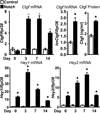Connective tissue growth factor is a target of notch signaling in cells of the osteoblastic lineage
- PMID: 24792956
- PMCID: PMC4069863
- DOI: 10.1016/j.bone.2014.04.028
Connective tissue growth factor is a target of notch signaling in cells of the osteoblastic lineage
Abstract
Connective tissue growth factor (Ctgf) or CCN2 is a protein synthesized by osteoblasts necessary for skeletal homeostasis, although its overexpression inhibits osteogenic signals and bone formation. Ctgf is induced by bone morphogenetic proteins, transforming growth factor β and Wnt; and in the present studies, we explored whether Notch regulated Ctgf expression in osteoblasts. We employed Rosa(Notch) mice, where the Notch intracellular domain (NICD) is expressed following the excision of a STOP cassette, placed between the Rosa26 promoter and NICD. Notch was activated by transduction of adenoviral vectors expressing Cre recombinase (Ad-CMV-Cre). Notch induced Ctgf mRNA levels in a time dependent manner and increased Ctgf heterogeneous nuclear RNA. Notch also destabilized Ctgf mRNA shortening its half-life from 13h to 3h. The effect of Notch on Ctgf expression was lost following Rbpjκ downregulation, demonstrating that it was mediated by Notch canonical signaling. However, downregulation of the classic Notch target genes Hes1, Hey1 and Hey2 did not modify the effect of Notch on Ctgf expression. Wild type osteoblasts exposed to immobilized Delta-like 1 displayed enhanced Notch signaling and increased Ctgf expression. In addition to the effects of Notch in vitro, Notch induced Ctgf in vivo, and calvariae and femurs from Rosa(Notch) mice mated with transgenics expressing the Cre recombinase in cells of the osteoblastic lineage exhibited increased expression of Ctgf. In conclusion, Ctgf is a target of Notch canonical signaling in osteoblasts, and may act in concert with Notch to regulate skeletal homeostasis.
Keywords: CCN proteins; Notch; connective tissue growth factor; osteoblasts; transcription.
Copyright © 2014 Elsevier Inc. All rights reserved.
Figures






Similar articles
-
Canonical Notch activation in osteocytes causes osteopetrosis.Am J Physiol Endocrinol Metab. 2016 Jan 15;310(2):E171-82. doi: 10.1152/ajpendo.00395.2015. Epub 2015 Nov 17. Am J Physiol Endocrinol Metab. 2016. PMID: 26578715 Free PMC article.
-
Connective tissue growth factor (CTGF) transactivates nuclear factor of activated T-cells (NFAT) in cells of the osteoblastic lineage.J Cell Biochem. 2010 May 15;110(2):477-83. doi: 10.1002/jcb.22561. J Cell Biochem. 2010. PMID: 20235153 Free PMC article.
-
Notch inhibits osteoblast differentiation and causes osteopenia.Endocrinology. 2008 Aug;149(8):3890-9. doi: 10.1210/en.2008-0140. Epub 2008 Apr 17. Endocrinology. 2008. PMID: 18420737 Free PMC article.
-
Osteoblast lineage-specific effects of notch activation in the skeleton.Endocrinology. 2013 Feb;154(2):623-34. doi: 10.1210/en.2012-1732. Epub 2012 Dec 28. Endocrinology. 2013. PMID: 23275471 Free PMC article.
-
Nuclear factor of activated T-cells (NFAT)C2 inhibits Notch receptor signaling in osteoblasts.J Biol Chem. 2013 Jan 4;288(1):624-32. doi: 10.1074/jbc.M112.340455. Epub 2012 Nov 19. J Biol Chem. 2013. PMID: 23166323 Free PMC article.
Cited by
-
Sustained Notch2 signaling in osteoblasts, but not in osteoclasts, is linked to osteopenia in a mouse model of Hajdu-Cheney syndrome.J Biol Chem. 2017 Jul 21;292(29):12232-12244. doi: 10.1074/jbc.M117.786129. Epub 2017 Jun 7. J Biol Chem. 2017. PMID: 28592489 Free PMC article.
-
Activation of Notch3 in osteoblasts/osteocytes causes compartment-specific changes in bone remodeling.J Biol Chem. 2021 Jan-Jun;296:100583. doi: 10.1016/j.jbc.2021.100583. Epub 2021 Mar 24. J Biol Chem. 2021. PMID: 33774049 Free PMC article.
-
Delta Like-1 Gene Mutation: A Novel Cause of Congenital Vertebral Malformation.Front Genet. 2019 Jun 5;10:534. doi: 10.3389/fgene.2019.00534. eCollection 2019. Front Genet. 2019. PMID: 31275352 Free PMC article.
-
Cancer-associated fibroblast-derived extracellular vesicles facilitate metastasis in hepatocellular carcinoma by delivering CTGF.Cell Oncol (Dordr). 2025 Jul 1. doi: 10.1007/s13402-025-01085-2. Online ahead of print. Cell Oncol (Dordr). 2025. PMID: 40591224
-
An antibody to Notch3 reverses the skeletal phenotype of lateral meningocele syndrome in male mice.J Cell Physiol. 2020 Jan;235(1):210-220. doi: 10.1002/jcp.28960. Epub 2019 Jun 12. J Cell Physiol. 2020. PMID: 31188489 Free PMC article.
References
-
- Canalis E, Economides AN, Gazzerro E. Bone morphogenetic proteins, their antagonists, and the skeleton. Endocr Rev. 2003;24:218–235. - PubMed
-
- Gazzerro E, Canalis E. Skeletal actions of insulin-like growth factors. Expert Rev Endocrinol Metab. 2006;1:47–56. - PubMed
-
- Canalis E. Wnt signalling in osteoporosis: mechanisms and novel therapeutic approaches. Nat Rev Endocrinol. 2013;9:575–583. - PubMed
Publication types
MeSH terms
Substances
Grants and funding
LinkOut - more resources
Full Text Sources
Other Literature Sources
Molecular Biology Databases
Miscellaneous

